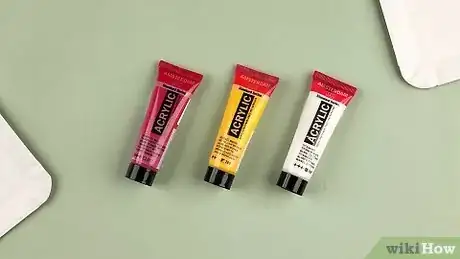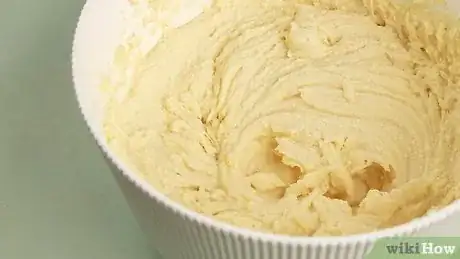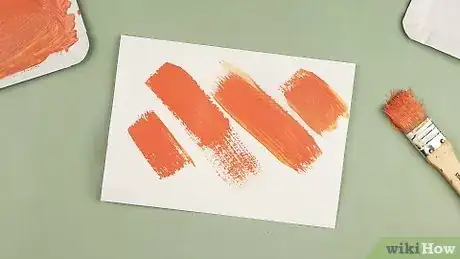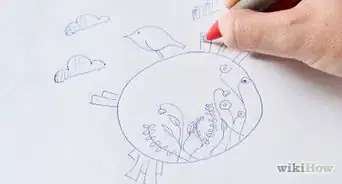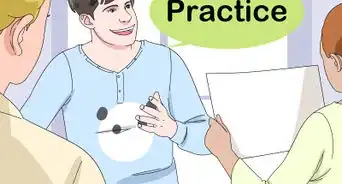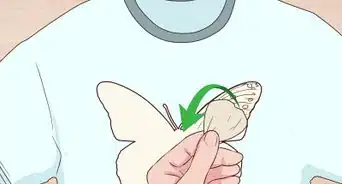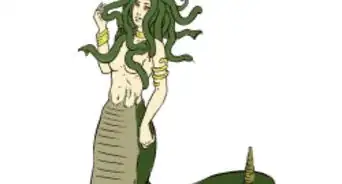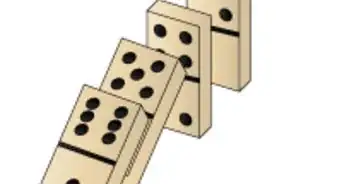This article was co-authored by Laura M. Johnson and by wikiHow staff writer, Hannah Madden. Laura M. Johnson is a Mural Artist and the Owner of Laura Margo Murals & Custom Art in St. Paul, Minnesota. She has over five years of experience in the industry and has worked professionally across venture capital, communications, the arts, and beyond. She helps empower small and growing businesses to find their voices, share their stories, and grow their impact. Laura received her Master of Business Administration from the University of Minnesota - Carlson School of Management, and her Bachelors in Journalism and Communication Studies with a minor in Fine Arts from the University of Oregon.
This article has been viewed 17,547 times.
When you’re working on an art project and you need the perfect shade of peach, making it yourself is your best option. Whether you’re working on someone’s skin tone or adding peaches to a fruit tree, blending your own color lets you control the shade, tone, and hue. In this article, we’ll tell you exactly how to make a peach color with paint, colored pencils, or food coloring so you can finish up your art project fast.
Things You Should Know
- Peach is made from a mix of red, yellow, and white.[1]
- Start by adding yellow to red. Then, add white until you reach the desired shade of peach.
- To use peach for a skin color, choose warmer shades of reds and yellows, such as cadmium red and yellow.
- If you want a cooler shade of peach, mix with cool-toned hues such as lemon yellow and crimson.
Steps
How to Mix Peach Paint
-
1Start with red, yellow, and white. These are the 3 primary colors that make up peach. Pour a dollop of paint onto your easel or a flat surface so you can mix them together easily.[2] [3]
- If you already have orange paint premixed, you can use it instead of red and yellow.
- You can mix each color in equal proportions, or play with having a bit more of one or two of the colors to achieve the precise shade of peach you want.
-
2Mix red and yellow together to make orange. Grab a paint brush or a pallet brush and mix a little bit of red and yellow together. You’re going for a light orange, so add more yellow if you need to.[4]Advertisement
-
3Add a large dollop of white to lighten the orange to peach. Once you’ve got an orange color, use your brush to add a hefty dollop of white paint. Keep stirring your paint together, and add more white until you’re satisfied with the peachy color.[5]
-
4Add more white or yellow to lighten the color. More yellow in your mixture will result in a coral, fruity color, similar to an unripe peach. Or, add white to lighten it without changing the tint.[6]
-
5Add more red to darken the color. Maybe you’re going for a more rusty, orange peach color. Use your brush to add a small dollop of red to darken your color. Remember, red goes a long way, so start small and work your way up.[7]
Making Peach with Colored Pencils
-
1Start with a very thin layer of red. Use a red colored pencil to shade your area, but use a very light hand. You’ll be layering other colors on top, so gently press the pencil down onto the paper.[8]
-
2Add a thin layer of yellow on top. Red and yellow mix to make a very light orange or peach color. Grab your yellow colored pencil and very lightly add a layer on top of your red color.[9]
-
3Keep layering until you reach your desired color. Use the red pencil again, then the yellow again, and then the red again. You can keep adding layers until you get the perfect shade of peach that you love.
-
4Add white for a more opaque color. If your peach color is a bit too transparent for your liking, grab a white colored pencil and go over the area. The white will blend all of the colors a bit more and make them harder to see through.
Making Peach with Food Coloring
-
1Start with plain white batter or frosting. Peach dye shows up the best when you start with a white base. Either whip up a batch of buttercream frosting or make some white vanilla cake batter to start out with.
-
2Add 50 drops of red food coloring. Don’t be alarmed—50 drops is only about 1⁄2 tsp (2.5 mL)! The red will create the base of the peach color.[10]
-
3Mix in 45 drops of yellow food coloring. You can use a spoon or a whisk to blend your 2 colors together. After mixing, you’ll notice them become a light orange or peach color for the perfect decorative element.[11]
Peach Color Theory
-
1Warm hues make a warm peach. If you’re looking for a bright, inviting peach color, choose warm reds (like cadmium red or scarlett) and yellows (like Indian yellow or cadmium yellow) to make your peach base. Warm colors often portray optimism and happiness in art and design.[12]
- A warm peach typically makes a great skin color, especially if your subject has warm undertones.
-
2Cool hues make a cool peach. Maybe you want a cooler, softer peach color to use in your work. In that case, gravitate toward cool yellows (like lemon yellow or yellow light) and reds (like crimson or rose) to make your peach. Cool tones often have a calming, relaxed feel to them.[13]
-
3Mix warm and cool hues to mute the peach color. Is your peach too vibrant or bright? In that case, try mixing a cool red and a warm yellow (or vice versa). The result will be a more muted peach color that doesn’t stand out as much.[14]
References
- ↑ https://marketingaccesspass.com/what-colors-make-peach-how-to-make-peach-color/
- ↑ https://www.youtube.com/watch?v=guEbR8hDwhA&t=28s
- ↑ https://marketingaccesspass.com/what-colors-make-peach-how-to-make-peach-color/
- ↑ https://www.youtube.com/watch?v=pQou0h9Mt4s&t=30s
- ↑ https://www.myhowtoonline.com/how-to-make-peach-colors/
- ↑ https://www.color-meanings.com/what-color-orange-pink-make-mixed/
- ↑ https://www.color-meanings.com/what-color-orange-pink-make-mixed/
- ↑ https://www.myhowtoonline.com/how-to-make-peach-colors/
- ↑ https://www.myhowtoonline.com/how-to-make-peach-colors/
- ↑ https://www.thekitchenwhisperer.net/2012/08/21/frost-by-numbers/
- ↑ https://www.thekitchenwhisperer.net/2012/08/21/frost-by-numbers/
- ↑ https://www.myhowtoonline.com/how-to-make-peach-colors/
- ↑ https://www.myhowtoonline.com/how-to-make-peach-colors/
- ↑ https://www.myhowtoonline.com/how-to-make-peach-colors/
